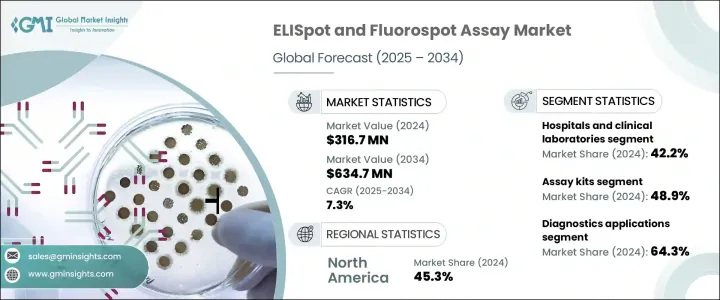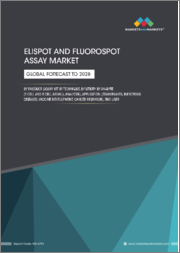
|
시장보고서
상품코드
1766209
ELISpot 및 Fluorospot 분석 시장 기회, 성장 촉진요인, 산업 동향 분석, 예측(2025-2034년)ELISpot and Fluorospot Assay Market Opportunity, Growth Drivers, Industry Trend Analysis, and Forecast 2025 - 2034 |
||||||
세계의 ELISpot 및 Fluorospot 분석 시장은 2024년 3억 1,670만 달러로 평가되었으며 CAGR 7.3%를 나타내 2034년에는 6억 3,470만 달러에 이를 것으로 추정됩니다.
ELISpot은 세포 수준, 특히 T 세포와 B 세포에서 사이토 카인과 항체의 분비를 검출하는 데 사용할 수있는 가장 민감한 기술 중 하나입니다. 양쪽 모두의 분석은 임상 연구, 백신 개발, 임상시험에 있어서 면역 모니터링에 널리 이용되고 있습니다.

이러한 분석은 특히 감염, 면역 요법 및 백신 연구를 대상으로 한 백신 접종 노력에서 면역 반응 모니터링에 중요한 역할을합니다. 결핵, 암, 신흥 바이러스 감염과 같은 질병의 이환율 증가는 첨단 면역학 분석의 필요성을 높이고 있습니다 ELISpot 및 Fluorospot 시스템은 고감도, 단일 세포 분해능, 다중화 능력으로 두드러지며 임상 및 조사 면역학에서 귀중한 도구가 되었습니다.
| 시장 범위 | |
|---|---|
| 시작 연도 | 2024년 |
| 예측 연도 | 2025-2034년 |
| 시작 금액 | 3억 1,670만 달러 |
| 예측 금액 | 6억 3,470만 달러 |
| CAGR | 7.3% |
2024년에는 어세이 키트 부문이 48.9%의 최대 점유율을 차지했습니다. 이러한 키트는 전염병, 암 면역 요법 및 이식 거부 반응의 모니터링에서 특히 인기가 있습니다.
진단 응용 분야는 2024년 최대 점유율 64.3%를 차지했습니다. 이는 주로 결핵, 자가면역 질환, 암 면역요법 및 기타 염증성 질환을 비롯한 다양한 감염의 진단에서 ELISpot 및 Fluorospot 분석의 사용이 증가하고 있기 때문입니다. 임상 진단에 필수적이며 정밀의료에서 중요한 도구로 자리매김하고 있습니다. 면역 관련 질환을 확인하고 그 진행을 모니터링하는 능력은 시장의 성장을 더욱 뒷받침하고 있습니다.
아시아태평양의 ELISpot 및 Fluorospot 분석 시장은 2025년부터 2034년까지 CAGR이 8%를 나타내 가장 높은 성장이 전망되고 있습니다. 중국, 인도, 한국과 같은 국가는 의료 의식의 고조와 유리한 규제 틀에 밀려, 이러한 기술을 빠르게 도입하고 있습니다.
시장 진출기업은 Bio-Techne Corporation, BD, Mabtech, Oxford Immunotec, Bio-Connect, Celular Technology, Abcam Limited, Steccell Technologies, Autoimmun Diagnostika, Lophius Biosciences, GenScript Biotech, Merck, R&D Systems, U-CyTech 등이 있습니다. ELISpot 및 Fluorospot 분석 시장의 각 회사는 시장에서의 위치를 강화하기 위해 더 높은 정확도와 해상도를 제공하는 혁신적이고 민감한 분석의 개발을 통한 제품 라인업 확대에 주력하고 있습니다. 기존 제품 라인을 강화하고 차세대 분석을 개발하기 위한 R&D에 투자하고 있습니다. 특히 태평양과 같은 신흥 시장의 전략적 지역 확대로 기업은 고급 진단 솔루션에 대한 수요 증가에 대응할 수 있게 되었습니다.
목차
제1장 조사 방법과 범위
제2장 주요 요약
제3장 업계 인사이트
- 생태계 분석
- 업계에 미치는 영향요인
- 성장 촉진요인
- 만성질환 및 감염증 발생률 상승
- 병의 조기 진단에의 의식의 고조
- 의료비 지출과 정부 지원 증가
- 업계의 잠재적 위험 및 과제
- 숙련된 인재의 부족
- 엄격한 규제 요건
- 성장 촉진요인
- 성장 가능성 분석
- 규제 상황
- 기술적 상황
- 향후 시장 동향
- 갭 분석
- Porter's Five Forces 분석
- PESTEL 분석
- 특허 분석
제4장 경쟁 구도
- 서론
- 기업의 시장 점유율 분석
- 기업 매트릭스 분석
- 주요 시장 기업의 경쟁 분석
- 경쟁 포지셔닝 매트릭스
- 전략 대시보드
제5장 시장 추계·예측 : 유형별(2021-2034년)
- 주요 동향
- 분석 키트
- 분석기
- 보조제품
제6장 시장 추계·예측 : 용도별(2021-2034년)
- 주요 동향
- 연구
- 진단
제7장 시장 추계·예측 : 최종 용도별(2021-2034년)
- 주요 동향
- 병원 및 임상 실험실
- 학술 및 연구기관
- 바이오의약품기업
- 기타 최종 용도
제8장 시장 추계·예측 : 지역별(2021-2034년)
- 주요 동향
- 북미
- 미국
- 캐나다
- 유럽
- 독일
- 영국
- 프랑스
- 스페인
- 이탈리아
- 네덜란드
- 아시아태평양
- 중국
- 인도
- 일본
- 호주
- 한국
- 라틴아메리카
- 브라질
- 멕시코
- 아르헨티나
- 중동 및 아프리카
- 사우디아라비아
- 남아프리카
- 아랍에미리트(UAE)
제9장 기업 프로파일
- BD
- Abcam Limited
- Autoimmun Diagnostika
- Bio-Connect
- Bio-Techne Corporation
- Cellular Technology
- GenScript Biotech
- Lophius Biosciences
- Mabtech
- Merck
- Oxford Immunotec
- R&D Systems
- Stemcell Technologies
- U-CyTech
The Global ELISpot and Fluorospot Assay Market was valued at USD 316.7 million in 2024 and is estimated to grow at a CAGR of 7.3% to reach USD 634.7 million by 2034. ELISpot is one of the most sensitive techniques available to detect cytokine or antibody secretion at the cellular level, specifically from T or B cells. The Fluorospot assay, an extension of the ELISpot, allows for the simultaneous detection of multiple proteins secreted from a single cell using fluorescent labeling. Both assays are widely used for immune monitoring in clinical research, vaccine development, and clinical studies. The rising prevalence of infectious and immune-related diseases is a significant driver for the increased demand for these assays.

These assays play a crucial role in monitoring immune responses, especially in vaccination efforts targeting infectious diseases, immunotherapies, and vaccine research. The growing incidence of diseases like tuberculosis, cancer, and emerging viral infections has intensified the need for advanced immunological assays. ELISpot and Fluorospot systems stand out for their high sensitivity, single-cell resolution, and multiplexing abilities, which make them invaluable tools in clinical and research immunology.
| Market Scope | |
|---|---|
| Start Year | 2024 |
| Forecast Year | 2025-2034 |
| Start Value | $316.7 Million |
| Forecast Value | $634.7 Million |
| CAGR | 7.3% |
In 2024, the assay kits segment held the largest share of 48.9%. This dominance can be attributed to the growing adoption of standardized kits that are easy to use, reproducible, and compatible with cell-mediated immunity research frameworks. The convenience of ready-to-use kits makes them a preferred choice in academic, clinical, and pharmaceutical research settings. These kits are particularly popular for their role in infectious disease, cancer immunotherapy, and transplant rejection monitoring. The high demand for cytokine-specific detection has contributed to the growing adoption of these assays. Furthermore, the increasing global burden of diseases continues to drive the need for these assay solutions.
The diagnostics application segment held the largest share 64.3% in 2024. This is primarily due to the increasing use of ELISpot and Fluorospot assays in the diagnosis of various infectious diseases, including tuberculosis, autoimmune disorders, cancer immunotherapy, and other inflammatory conditions. The assays' high accuracy makes them essential in clinical diagnostics, positioning them as key tools in precision medicine. Their ability to identify and monitor the progression of immune-related disorders further propels market growth. This trend highlights the critical role these assays play in both the diagnosis and management of diseases, cementing their importance in clinical settings.
Asia Pacific ELISpot and Fluorospot Assay Market is expected to witness the highest growth, with a CAGR of 8% from 2025 to 2034. The growth is driven by the rising adoption of healthcare technologies, significant investments in immunological research, and the increasing prevalence of infectious diseases such as tuberculosis and viral infections in the region. Countries like China, India, and South Korea are rapidly embracing these technologies, aided by heightened healthcare awareness and favorable regulatory frameworks. The growing biopharmaceutical industry and an increase in clinical trial activity are further contributing to the demand for precise immune surveillance tools like ELISpot and Fluorospot assays.
The market features major participants including Bio-Techne Corporation, BD, Mabtech, Oxford Immunotec, Bio-Connect, Cellular Technology, Abcam Limited, Stemcell Technologies, Autoimmun Diagnostika, Lophius Biosciences, GenScript Biotech, Merck, R&D Systems, U-CyTech. To strengthen their market position, companies in the ELISpot and Fluorospot assay market are focusing on expanding their product offerings by developing innovative and more sensitive assays that provide higher accuracy and resolution. Partnerships and collaborations with academic institutions, healthcare providers, and pharmaceutical companies are becoming a key strategy to promote the widespread adoption of these assays. Additionally, companies are investing in research and development to enhance their existing product lines and create next-generation assays. Efforts to integrate automation, improve ease of use, and offer ready-to-use kits are also crucial in making these assays more accessible to a wider range of research and clinical users. Moreover, strategic regional expansion, particularly in emerging markets like Asia Pacific, is enabling companies to tap into the growing demand for advanced diagnostic solutions.
Table of Contents
Chapter 1 Methodology and Scope
- 1.1 Market scope and definitions
- 1.2 Research design
- 1.2.1 Research approach
- 1.2.2 Data collection methods
- 1.3 Base estimates and calculations
- 1.3.1 Base year calculation
- 1.3.2 Key trends for market estimation
- 1.4 Forecast model
- 1.5 Primary research and validation
- 1.5.1 Primary sources
- 1.5.2 Data mining sources
Chapter 2 Executive Summary
- 2.1 Industry 3600 synopsis
Chapter 3 Industry Insights
- 3.1 Industry ecosystem analysis
- 3.2 Industry impact forces
- 3.2.1 Growth drivers
- 3.2.1.1 Rising incidence of chronic and infectious diseases
- 3.2.1.2 Growing awareness of early disease diagnosis
- 3.2.1.3 Increasing healthcare spending and government support
- 3.2.2 Industry pitfalls and challenges
- 3.2.2.1 Lack of skilled personnel
- 3.2.2.2 Stringent regulatory requirements
- 3.2.1 Growth drivers
- 3.3 Growth potential analysis
- 3.4 Regulatory landscape
- 3.5 Technological landscape
- 3.6 Future market trends
- 3.7 Gap analysis
- 3.8 Porter's analysis
- 3.9 PESTEL analysis
- 3.10 Patent Analysis
Chapter 4 Competitive Landscape, 2024
- 4.1 Introduction
- 4.2 Company market share analysis
- 4.3 Company matrix analysis
- 4.4 Competitive analysis of major market players
- 4.5 Competitive positioning matrix
- 4.6 Strategy dashboard
Chapter 5 Market Estimates and Forecast, By Type, 2021 – 2034 ($ Mn)
- 5.1 Key trends
- 5.2 Assay kits
- 5.3 Analyzers
- 5.4 Ancillary products
Chapter 6 Market Estimates and Forecast, By Application, 2021 – 2034 ($ Mn)
- 6.1 Key trends
- 6.2 Research applications
- 6.3 Diagnostics applications
Chapter 7 Market Estimates and Forecast, By End Use, 2021 – 2034 ($ Mn)
- 7.1 Key trends
- 7.2 Hospitals and clinical laboratories
- 7.3 Academic and research institutions
- 7.4 Biopharmaceutical companies
- 7.5 Other end use
Chapter 8 Market Estimates and Forecast, By Region, 2021 – 2034 ($ Mn)
- 8.1 Key trends
- 8.2 North America
- 8.2.1 U.S.
- 8.2.2 Canada
- 8.3 Europe
- 8.3.1 Germany
- 8.3.2 UK
- 8.3.3 France
- 8.3.4 Spain
- 8.3.5 Italy
- 8.3.6 Netherlands
- 8.4 Asia Pacific
- 8.4.1 China
- 8.4.2 India
- 8.4.3 Japan
- 8.4.4 Australia
- 8.4.5 South Korea
- 8.5 Latin America
- 8.5.1 Brazil
- 8.5.2 Mexico
- 8.5.3 Argentina
- 8.6 Middle East and Africa
- 8.6.1 Saudi Arabia
- 8.6.2 South Africa
- 8.6.3 UAE
Chapter 9 Company Profiles
- 9.1 BD
- 9.2 Abcam Limited
- 9.3 Autoimmun Diagnostika
- 9.4 Bio-Connect
- 9.5 Bio-Techne Corporation
- 9.6 Cellular Technology
- 9.7 GenScript Biotech
- 9.8 Lophius Biosciences
- 9.9 Mabtech
- 9.10 Merck
- 9.11 Oxford Immunotec
- 9.12 R&D Systems
- 9.13 Stemcell Technologies
- 9.14 U-CyTech



















